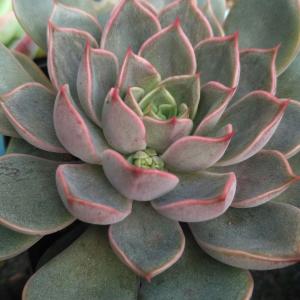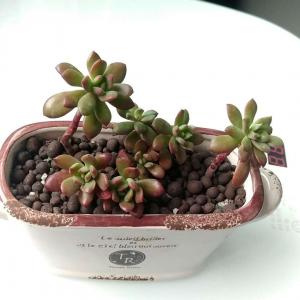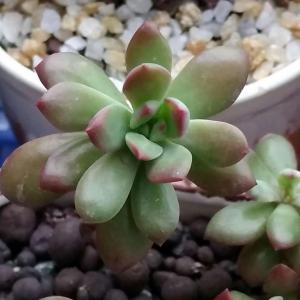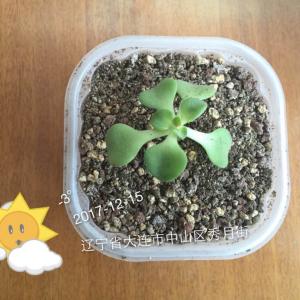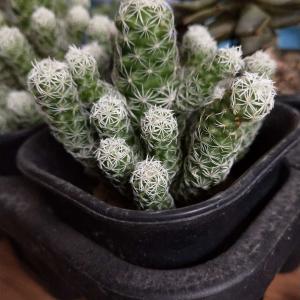旃檀ཙན་དན
2017年12月15日

格桑花太好种了,只要种子新鲜,播下2,3天就能发芽。2个月不到已经长出花苞了,大冬天的,不知道还能不能开出🌼来








0
0
旃檀ཙན་དན:@醇香云烟 很难说,得看环境。我是养在南阳光房里,白天太阳直晒下,阳光房内温度能有将近20度
醇香云烟:北方能种活吗
文章
Miss Chen
2017年12月14日

Description: This perennial plant is 1½–2' tall and unbranched. The central stem is light green to light purplish green and more or less pubescent. Several pairs of opposite leaves occur along the entire length of the stem; they are more or less ascending. The leaves are often folded upward along their margins, where they are often wavy (up and down). Individual leaves are up to 5" long and 1½" across; they are linear-lanceolate to lanceolate in shape and smooth (entire) along their margins. The upper leaf surface is medium green, while the lower leaf surface is light green; both surfaces are short-pubescent to nearly glabrous. The petioles are about 3 mm. (1/8") long, light green to light reddish green, and pubescent. The primary veins of the leaves are pinnate, while their secondary veins form a reticulated network that is visible on their undersides. From the axils of middle to upper leaves, there are nodding umbels of flowers spanning 1–1¾" across (only one umbel per pair of leaves). These umbels have short pubescent peduncles up to 6 mm. (¼") long. A typical plant will have 1-4 umbels; each umbel has 15-45 flowers on hairy pedicels about ½" long. Individual umbels are broadly obconic to half-globoid in shape and dome-shaped in front, rather than flat-headed.
Each flower is about 8 mm. long and 3 mm. across, consisting of 5 erect hoods, 5 deflexed petals, 5 deflexed sepals, and the reproductive organs. The flowers are light green to green, becoming yellowish green or purplish green as they age. Individual hoods are lanceolate-oblong in shape; they are without horns. The hoods surround a central reproductive column on all sides; this column contains masses of winged pollinia (packets of pollen). The deflexed petals are lanceolate in shape; when the flower is fully open, they hide the shorter sepals. The sepals are linear-lanceolate in shape, light green to purplish green, and hairy. The blooming period occurs during early summer, lasting about 3 weeks. Afterwards, the flowers that have been cross-pollinated successfully (if any) are replaced by follicles (seedpods that open along one side). The follicles are up to 3½–5" long and ½–¾" across; they are narrowly lanceoloid and usually short-pubescent. During the autumn, these follicles split open to release their seeds. The seeds are dark brown, flattened-ovoid in shape, and winged along their margins. At their apices, the seeds have tufts of white hair; they are distributed by the wind. The root system consists of a central taproot. This plant usually occurs as scattered individuals, rarely forming colonies.

Cultivation: The preference is full sun and dry-mesic to dry conditions. This plant will also tolerate partial sun and mesic conditions. If anything, poor soil is preferred, containing gravelly or sandy material, as this reduces competition from taller plants. However, rich loam is tolerated if it is well-drained. After the blooming period and during the development of seedpods, this plant gradually deteriorates.
Range & Habitat: The native Short Green Milkweed is widely distributed in Illinois, but it is absent from some eastern and central counties (see Distribution Map). In areas where it occurs, this plant is rare to occasional. Habitats include openings in upland forests that are rocky or sandy; upland black soil prairies, sand prairies, gravel prairies, and hill prairies; barrens, limestone glades, and sand dunes; and abandoned fields. Short Green Milkweed usually occurs in high quality habitats, rather than degraded areas. Occasional wildfires are probably beneficial by reducing competition from woody vegetation.

Faunal Associations: The nectar of the flowers attracts primarily bumblebees, which are the primary pollinators (Robertson, 1929). Ants are also attracted to the nectar, but they are not effective at cross-pollination. Some insects feed destructively on Short Green Milkweed and other milkweeds (Asclepias spp.). For example, larvae of a long-horned beetle, Tetraopes texanus (Texas Milkweed Beetle), bore through the stems of Short Green Milkweed, while caterpillars of a butterfly, Danaus plexippus (Monarch), occasionally feed on the leaves. Other insects that feed on milkweeds are listed in the Insect Table. Mammalian herbivores avoid consumption of the foliage because its milky latex contains toxic cardiac glycosides and it is bitter-tasting. Because caterpillars of the Monarch butterfly are able to sequester these toxic chemicals, the adults of this insect are usually avoided by birds.

Photographic Location: The photographs were taken at the Prospect Cemetery Prairie in Ford County, Illinois, and the Coneflower Hill Prairie in Shelby County, Illinois.
Comments: This non-showy plant is unlikely to receive favor from the mass market in horticulture, but it is nonetheless quite interesting to examine. This milkweed species is rather variable across different localities; there is a variety with narrow leaves that occurs in sandy areas near Lake Michigan. Short Green Milkweed (Asclepias viridiflora) can be distinguished from many species of milkweeds by its nodding umbels of greenish flowers. The rare Mead's Milkweed (Asclepias meadii) has this characteristic, but its flowers are more wide (about 6 mm. across) and the hoods of its flowers have horns. Another milkweed species, Tall Green Milkweed (Asclepias hirtella), produces nodding umbels of greenish flowers, but its umbels are more fully globoid in shape, and its leaves are usually more linear and narrow than those of Short Green Milkweed.
Each flower is about 8 mm. long and 3 mm. across, consisting of 5 erect hoods, 5 deflexed petals, 5 deflexed sepals, and the reproductive organs. The flowers are light green to green, becoming yellowish green or purplish green as they age. Individual hoods are lanceolate-oblong in shape; they are without horns. The hoods surround a central reproductive column on all sides; this column contains masses of winged pollinia (packets of pollen). The deflexed petals are lanceolate in shape; when the flower is fully open, they hide the shorter sepals. The sepals are linear-lanceolate in shape, light green to purplish green, and hairy. The blooming period occurs during early summer, lasting about 3 weeks. Afterwards, the flowers that have been cross-pollinated successfully (if any) are replaced by follicles (seedpods that open along one side). The follicles are up to 3½–5" long and ½–¾" across; they are narrowly lanceoloid and usually short-pubescent. During the autumn, these follicles split open to release their seeds. The seeds are dark brown, flattened-ovoid in shape, and winged along their margins. At their apices, the seeds have tufts of white hair; they are distributed by the wind. The root system consists of a central taproot. This plant usually occurs as scattered individuals, rarely forming colonies.

Cultivation: The preference is full sun and dry-mesic to dry conditions. This plant will also tolerate partial sun and mesic conditions. If anything, poor soil is preferred, containing gravelly or sandy material, as this reduces competition from taller plants. However, rich loam is tolerated if it is well-drained. After the blooming period and during the development of seedpods, this plant gradually deteriorates.
Range & Habitat: The native Short Green Milkweed is widely distributed in Illinois, but it is absent from some eastern and central counties (see Distribution Map). In areas where it occurs, this plant is rare to occasional. Habitats include openings in upland forests that are rocky or sandy; upland black soil prairies, sand prairies, gravel prairies, and hill prairies; barrens, limestone glades, and sand dunes; and abandoned fields. Short Green Milkweed usually occurs in high quality habitats, rather than degraded areas. Occasional wildfires are probably beneficial by reducing competition from woody vegetation.

Faunal Associations: The nectar of the flowers attracts primarily bumblebees, which are the primary pollinators (Robertson, 1929). Ants are also attracted to the nectar, but they are not effective at cross-pollination. Some insects feed destructively on Short Green Milkweed and other milkweeds (Asclepias spp.). For example, larvae of a long-horned beetle, Tetraopes texanus (Texas Milkweed Beetle), bore through the stems of Short Green Milkweed, while caterpillars of a butterfly, Danaus plexippus (Monarch), occasionally feed on the leaves. Other insects that feed on milkweeds are listed in the Insect Table. Mammalian herbivores avoid consumption of the foliage because its milky latex contains toxic cardiac glycosides and it is bitter-tasting. Because caterpillars of the Monarch butterfly are able to sequester these toxic chemicals, the adults of this insect are usually avoided by birds.

Photographic Location: The photographs were taken at the Prospect Cemetery Prairie in Ford County, Illinois, and the Coneflower Hill Prairie in Shelby County, Illinois.
Comments: This non-showy plant is unlikely to receive favor from the mass market in horticulture, but it is nonetheless quite interesting to examine. This milkweed species is rather variable across different localities; there is a variety with narrow leaves that occurs in sandy areas near Lake Michigan. Short Green Milkweed (Asclepias viridiflora) can be distinguished from many species of milkweeds by its nodding umbels of greenish flowers. The rare Mead's Milkweed (Asclepias meadii) has this characteristic, but its flowers are more wide (about 6 mm. across) and the hoods of its flowers have horns. Another milkweed species, Tall Green Milkweed (Asclepias hirtella), produces nodding umbels of greenish flowers, but its umbels are more fully globoid in shape, and its leaves are usually more linear and narrow than those of Short Green Milkweed.
0
0
文章
Miss Chen
2017年12月14日

Description: This perennial herbaceous plant is ½–2' tall and more or less erect; it is either unbranched or sparingly branched along the upper half of its central stem. The central stem is yellowish green or medium green and terete; it has vertical lines of short pubescence. Whorls of 4-6 leaves occur along the nodes of the central stem; because the internodes of this stem are fairly short, these leaves are produced in abundance. Relative to the orientation of the central stem, the leaves are usually ascending, although sometimes they are widely spreading or drooping. The leaves are 2-3" long, 2-3 mm. across, and linear in shape; their margins are entire (toothless) and strongly revolute (rolled downward). Sometimes whorls of smaller secondary leaves are produced from short lateral stems that develop from the axils of leaves along the central stem. The upper leaf surfaces are yellowish green or medium green and glabrous to sparsely short-pubescent; they are narrowly grooved along the middle where the midribs occur. The lower leaf surfaces are whitish green and short-pubescent; they are partially obscured by the rolled leaf margins. The leaves are sessile or they have very short petioles (less than 2 mm. long). From the axils of middle to upper leaves, umbels of flowers are produced on short peduncles (flowering stalks); there can be 1-4 umbels of flowers at each node. Individual umbels span ¾–1½" across, consisting of 7-20 pedicellate flowers.
Each flower is about 5-6 mm. across and 8-10 mm. long, consisting of 5 sepals, 5 petals, 5 hoods with horns, and a central reproductive column. The sepals are light green, short-pubescent, and lanceolate in shape; sometimes they are tinted purple toward their tips. These sepals are visible at the bases of flower buds, but they are hidden by the petals when the flowers bloom. The petals are white or greenish white, sometimes with pale purplish tints toward their tips; they are oblong-elliptic in shape and strongly declined (bent downward), curving slightly upward toward their tips. The erect white hoods are open-tubular in shape and somewhat oblique, their lower sides facing the center of the flower. The slender white horns are sickle-shaped and inwardly curved; there is one exserted horn per hood. The short reproductive column is white at its apex and light green below. The slender pedicels of the flowers are light green to nearly white, sometimes becoming purplish at their bases; they are 8-12 mm. long, terete, and short-pubescent. The peduncles are ½–1½" long, light to medium green, glabrous to short-pubescent, terete, and ascending. The blooming period occurs from early to late summer, lasting about 1-2 months. There is little or no floral scent. Afterwards, successfully cross-pollinated flowers are replaced by ascending to erect follicles (seedpods that open along one side). These follicles are 3-4" long and about ½" across; they are narrowly lanceoloid in shape and fairly smooth (lacking warts or soft prickles). At maturity during autumn or winter, these follicles split open to release their seeds to the wind. Mature seeds are about 4-5 mm. long, ovate-flattened in shape, brown, and narrowly winged along their margins; their apices have large tufts of white hair. The root system is fleshy-fibrous and long-rhizomatous. Colonies of clonal plants are often produced from the rhizomes.

Cultivation: The preference is full sun, mesic to dry conditions, and soil containing loam, clay-loam, sand, or gravel. Infertile soil is actually preferred because it reduces competition from taller plants. During hot dry weather, the lower leaves may turn yellow and fall off, or the foliage of the entire plant may become yellowish green. In open sunny areas with exposed soil, this plant can spread aggressively.
Range & Habitat: The native Whorled Milkweed occurs occasionally throughout most of Illinois, except for a few southern counties (see Distribution Map), where it is rare or absent. Habitats include upland prairies, sand prairies, gravel prairies, hill prairies, openings in rocky upland forests, sandy savannas, limestone glades, rocky bluffs along major rivers, bluegrass meadows, pastures and abandoned fields, grassy slopes along highways, and waste areas. Whorled Milkweed is a pioneer species that prefers open disturbed areas.
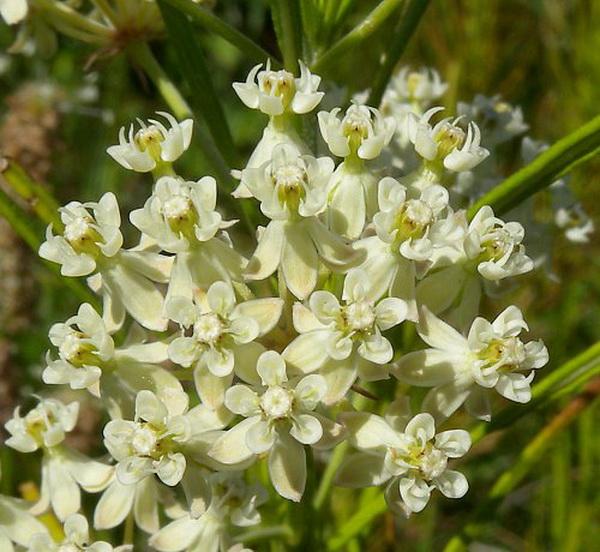
Faunal Associations: The nectar of the flowers attracts many kinds of insects, including honeybees, bumblebees, Halictid bees (Halictus spp., Lasioglossum spp.), Halictid cuckoo bees (Sphecodes spp.), sand-loving wasps (Tachytes spp.), weevil wasps (Cerceris spp.), Sphecid wasps (Sphex spp., Prionyx spp.), Five-banded Tiphiid Wasp (Myzinum quinquecinctum), Northern Paper Wasp (Polites fuscatus), spider wasps (Anoplius spp.), Eumenine wasps (Euodynerus spp., etc.), Syrphid flies, thick-headed flies (Physocephala spp., etc.), Tachinid flies, flesh flies (Sarcophagidae), Muscid flies, Painted Lady (Vanessa cardui) and other butterflies, Peck's Skipper (Polites peckius) and other skippers, Squash Vine Borer Moth (Melittia cucurbitae) and other moths, and Pennsylvania Soldier Beetle (Chauliognathus pennsylvanicus); sources of information include Robertson (1929) and personal observations. Among these floral visitors, bees and wasps are usually more effective at cross-pollination. Some insects feed destructively on the foliage, flowers, seedpods, and other parts of Whorled Milkweed. These species include the Small Milkweed Bug (Lygaeus kalmii), Milkweed Leaf Beetle (Labidomera clivicollis), Yellow Milkweed Aphid (Aphis nerii), and a moth, the Delicate Cycnia (Cycnia tenera). Although this insect does not occur in Illinois, in the southwestern United States, the Horsetail Milkweed Longhorn (Tetraopes discoideus) feeds on Whorled Milkweed and closely related milkweed species (Asclepias spp.); sources of information include Betz et al. (1997), Yanega (1996), and personal observations. Mammalian herbivores usually avoid the foliage of Whorled Milkweed as a food source because it is one of the more toxic milkweed species.

Photographic Location: Photographs were taken at the webmaster's wildflower garden in Urbana, Illinois, and a bluegrass meadow near Parkland College in Champaign, Illinois.
Comments: This small milkweed blooms later in the year than most milkweed species (Asclepias spp.), and its small umbels of flowers attract many kinds of insects, including butterflies. Whorled Milkweed (Asclepias verticillata) superficially resembles the common Field Horsetail (Equisetum arvense) because of its whorled linear leaves. It can be distinguished from this latter species by the milky latex of its foliage and the later development of its flowers and seedpods. Field Horsetail is a spore-bearing plant that lacks true flowers. Whorled Milkweed is readily distinguished from other milkweed species in Illinois by its more narrow leaves (only 2-3 mm. across). Narrow-leaved Milkweed (Asclepias stenophylla) is an exception, because its linear leaves are almost as narrow. However, this latter species has leaves that are alternate to nearly opposite along its stems, rather than whorled. So far, it has been found in only a few counties of western Illinois.
Each flower is about 5-6 mm. across and 8-10 mm. long, consisting of 5 sepals, 5 petals, 5 hoods with horns, and a central reproductive column. The sepals are light green, short-pubescent, and lanceolate in shape; sometimes they are tinted purple toward their tips. These sepals are visible at the bases of flower buds, but they are hidden by the petals when the flowers bloom. The petals are white or greenish white, sometimes with pale purplish tints toward their tips; they are oblong-elliptic in shape and strongly declined (bent downward), curving slightly upward toward their tips. The erect white hoods are open-tubular in shape and somewhat oblique, their lower sides facing the center of the flower. The slender white horns are sickle-shaped and inwardly curved; there is one exserted horn per hood. The short reproductive column is white at its apex and light green below. The slender pedicels of the flowers are light green to nearly white, sometimes becoming purplish at their bases; they are 8-12 mm. long, terete, and short-pubescent. The peduncles are ½–1½" long, light to medium green, glabrous to short-pubescent, terete, and ascending. The blooming period occurs from early to late summer, lasting about 1-2 months. There is little or no floral scent. Afterwards, successfully cross-pollinated flowers are replaced by ascending to erect follicles (seedpods that open along one side). These follicles are 3-4" long and about ½" across; they are narrowly lanceoloid in shape and fairly smooth (lacking warts or soft prickles). At maturity during autumn or winter, these follicles split open to release their seeds to the wind. Mature seeds are about 4-5 mm. long, ovate-flattened in shape, brown, and narrowly winged along their margins; their apices have large tufts of white hair. The root system is fleshy-fibrous and long-rhizomatous. Colonies of clonal plants are often produced from the rhizomes.

Cultivation: The preference is full sun, mesic to dry conditions, and soil containing loam, clay-loam, sand, or gravel. Infertile soil is actually preferred because it reduces competition from taller plants. During hot dry weather, the lower leaves may turn yellow and fall off, or the foliage of the entire plant may become yellowish green. In open sunny areas with exposed soil, this plant can spread aggressively.
Range & Habitat: The native Whorled Milkweed occurs occasionally throughout most of Illinois, except for a few southern counties (see Distribution Map), where it is rare or absent. Habitats include upland prairies, sand prairies, gravel prairies, hill prairies, openings in rocky upland forests, sandy savannas, limestone glades, rocky bluffs along major rivers, bluegrass meadows, pastures and abandoned fields, grassy slopes along highways, and waste areas. Whorled Milkweed is a pioneer species that prefers open disturbed areas.

Faunal Associations: The nectar of the flowers attracts many kinds of insects, including honeybees, bumblebees, Halictid bees (Halictus spp., Lasioglossum spp.), Halictid cuckoo bees (Sphecodes spp.), sand-loving wasps (Tachytes spp.), weevil wasps (Cerceris spp.), Sphecid wasps (Sphex spp., Prionyx spp.), Five-banded Tiphiid Wasp (Myzinum quinquecinctum), Northern Paper Wasp (Polites fuscatus), spider wasps (Anoplius spp.), Eumenine wasps (Euodynerus spp., etc.), Syrphid flies, thick-headed flies (Physocephala spp., etc.), Tachinid flies, flesh flies (Sarcophagidae), Muscid flies, Painted Lady (Vanessa cardui) and other butterflies, Peck's Skipper (Polites peckius) and other skippers, Squash Vine Borer Moth (Melittia cucurbitae) and other moths, and Pennsylvania Soldier Beetle (Chauliognathus pennsylvanicus); sources of information include Robertson (1929) and personal observations. Among these floral visitors, bees and wasps are usually more effective at cross-pollination. Some insects feed destructively on the foliage, flowers, seedpods, and other parts of Whorled Milkweed. These species include the Small Milkweed Bug (Lygaeus kalmii), Milkweed Leaf Beetle (Labidomera clivicollis), Yellow Milkweed Aphid (Aphis nerii), and a moth, the Delicate Cycnia (Cycnia tenera). Although this insect does not occur in Illinois, in the southwestern United States, the Horsetail Milkweed Longhorn (Tetraopes discoideus) feeds on Whorled Milkweed and closely related milkweed species (Asclepias spp.); sources of information include Betz et al. (1997), Yanega (1996), and personal observations. Mammalian herbivores usually avoid the foliage of Whorled Milkweed as a food source because it is one of the more toxic milkweed species.

Photographic Location: Photographs were taken at the webmaster's wildflower garden in Urbana, Illinois, and a bluegrass meadow near Parkland College in Champaign, Illinois.
Comments: This small milkweed blooms later in the year than most milkweed species (Asclepias spp.), and its small umbels of flowers attract many kinds of insects, including butterflies. Whorled Milkweed (Asclepias verticillata) superficially resembles the common Field Horsetail (Equisetum arvense) because of its whorled linear leaves. It can be distinguished from this latter species by the milky latex of its foliage and the later development of its flowers and seedpods. Field Horsetail is a spore-bearing plant that lacks true flowers. Whorled Milkweed is readily distinguished from other milkweed species in Illinois by its more narrow leaves (only 2-3 mm. across). Narrow-leaved Milkweed (Asclepias stenophylla) is an exception, because its linear leaves are almost as narrow. However, this latter species has leaves that are alternate to nearly opposite along its stems, rather than whorled. So far, it has been found in only a few counties of western Illinois.
0
0
文章
Miss Chen
2017年12月14日

Description: This herbaceous perennial plant is 1-2½' tall. Young plants develop from a single central stem, while older plants tiller at the base, sending up multiple erect to ascending stems from a large taproot. These stems are unbranched below, becoming branched above where the flowers occur. The stems are light green to dull reddish purple, terete, and more or less covered with spreading hairs. Densely distributed along these stems, are alternate leaves that differ little in size. These leaves are 2½–3½" long and ½–¾" across; they are linear-oblong to lanceolate-oblong in shape, while their margins are entire (toothless). The tips of the leaves are acute, while their bases are slightly cordate, truncate, or rounded. The leaves are sessile, or they have short petioles up to 3 mm. long. The upper leaf surface is medium to dark green and glabrous to sparsely short-pubescent, while the lower leaf surface is light to light-medium green and mostly short-pubescent. Along the lower sides of the major veins, this pubescence is somewhat longer. The foliage of this plant lacks a milky latex. Usually several umbels of flowers develop from the upper stems and the axils of upper leaves. These umbels span 1–2½" across, consisting of 8-25 flowers each; they are slightly dome-shaped and often horizontally adjacent to each other.
Each flower consists of 5 sepals, 5 petals, 5 hoods with horns, and a central reproductive column that is white to light green and short. The sepals are light green, hairy, and lanceolate in shape; they are largely hidden when the flowers open. The petals are more or less orange, lanceolate in shape, and declined (bent downward). The hoods are more or less orange, erect, and curved-ovate, forming open oblique tubes. The horns are more or less orange, sickle-shaped, incurved, and exserted from the hoods (one horn per hood). Usually the petals, hoods, and horns are orange, but sometimes they are reddish orange or yellowish orange. The pedicels are ¾–1½" long, light green or light reddish purple, terete, and more or less covered with spreading hairs. At the base of these pedicels, there are several spreading bracts up to 8 mm. long; they are green, linear-lanceolate in shape, and pubescent. The peduncles of the umbels are ½–2½" long, light green to dull reddish purple, terete, and hairy. The flowers bloom during early to mid-summer and sometimes a second time during late summer to early autumn. The flowers are relatively long-lasting, but they have no noticeable fragrance. Flowers that have been successfully cross-pollinated are replaced by follicles (seedpods that open along one side). These follicles are 4-6" long and ½–¾" across at maturity; they are initially light green, but later turn brown. The follicle surface is smooth and short-pubescent. These follicles eventually split open to release their seeds to the wind. Mature seeds are about 4 mm. long, flattened-oval in shape, brown, and narrowly winged along their margins; the apices of these seeds have large tufts of white hair. The root system consists of a woody taproot that is thick and knobby. This taproot can extend several feet below the ground surface.

Cultivation: The preference is full sun, mesic to dry conditions, and an acidic soil that is sandy or rocky. However, this plant will adapt to other kinds of soil, including those that contain loam or clay, if they are well-drained. Although this plant develops somewhat slowly, it is easy to cultivate in open sunny areas once it becomes established. Tolerance to hot dry weather is excellent. If the taproot of a young plant is planted too close to the soil surface, it may become damaged by frost due to heaving of the soil.
Range & Habitat: The native Butterfly Milkweed is occasional to locally common in Illinois, except for the western section of the state, where it is less common (see Distribution Map). Habitats include upland sand prairies, hill prairies, cemetery prairies, sandy savannas, open rocky woodlands, shale and sandstone glades (in southern Illinois), abandoned sandy fields, roadside embankments, and areas along railroads. Because of the showy orange flowers, Butterfly Milkweed is often cultivated in gardens. This milkweed is found in both disturbed areas and high quality natural areas. Occasional wildfires are probably beneficial in maintaining populations of this plant as this reduces competition from woody vegetation and taller herbaceous vegetation.

Faunal Associations: The flower nectar attracts honeybees, digger bees (Melissodes spp.), leaf-cutting bees (Megachile spp.), Halictid bees (including green metallic bees), thread-waisted wasps (Ammophila spp.) and other Sphecid wasps, and butterflies, including Fritillaries (Speyeria spp.), Swallowtails (Papilio spp.), and the Monarch (Danaus plexippus); see Robertson (1929). The Ruby-throated Hummingbird is also attracted to the flowers. Some insects feed destructively on the leaves, flowers and buds, seedpods, and other parts of Butterfly Milkweed. These insects include larvae of the Blackened Milkweed Beetle (Tetraopes melanurus), the Small Milkweed Bug (Lygaeus kalmii), the Large Milkweed Bug (Oncopeltus fasciatus), larvae of a butterfly, the Monarch (Danaus plexippus), and larvae of a moth, the Unexpected Cycnia (Cycnia inopinatus). Butterfly Milkweed is the preferred host plant of the preceding moth (see Yanega, 1996; Betz et al., 1997; Wagner, 2005). A polyphagous insect, the Curve-tailed Bush Katydid (Scudderia curvicauda), was observed to feed on the leaves of this milkweed (Gangwere, 1961); it may also feed on the flowers. While the foliage of Butterfly Milkweed lacks the toxic milky latex that is typical of other milkweeds (Asclepias spp.), mammalian herbivores nonetheless appear to avoid it.

Photographic Location: The above photographs were taken at the webmaster's wildflower garden, Urbana, Illinois, and a flower garden at the Anita Purvis Nature Center of the same city.
Comments: This is perhaps the showiest of the milkweeds (Asclepias spp.) because of the long-lasting and colorful flowers. Because Butterfly Milkweed (Asclepias tuberosa) is the only milkweed in Illinois that has orange flowers, it is easy to identify. This species is also unusual for a milkweed because its leaves are alternate and its foliage lacks a milky latex. Because of the absence of milky latex, it is often referred to as Butterfly Weed, rather than Butterfly Milkweed. The thick and bitter-tasting roots were used for various medicinal purposes in the past, including the treatment of pleurisy. As a result, another common name for this species is Pleurisy Root.
Each flower consists of 5 sepals, 5 petals, 5 hoods with horns, and a central reproductive column that is white to light green and short. The sepals are light green, hairy, and lanceolate in shape; they are largely hidden when the flowers open. The petals are more or less orange, lanceolate in shape, and declined (bent downward). The hoods are more or less orange, erect, and curved-ovate, forming open oblique tubes. The horns are more or less orange, sickle-shaped, incurved, and exserted from the hoods (one horn per hood). Usually the petals, hoods, and horns are orange, but sometimes they are reddish orange or yellowish orange. The pedicels are ¾–1½" long, light green or light reddish purple, terete, and more or less covered with spreading hairs. At the base of these pedicels, there are several spreading bracts up to 8 mm. long; they are green, linear-lanceolate in shape, and pubescent. The peduncles of the umbels are ½–2½" long, light green to dull reddish purple, terete, and hairy. The flowers bloom during early to mid-summer and sometimes a second time during late summer to early autumn. The flowers are relatively long-lasting, but they have no noticeable fragrance. Flowers that have been successfully cross-pollinated are replaced by follicles (seedpods that open along one side). These follicles are 4-6" long and ½–¾" across at maturity; they are initially light green, but later turn brown. The follicle surface is smooth and short-pubescent. These follicles eventually split open to release their seeds to the wind. Mature seeds are about 4 mm. long, flattened-oval in shape, brown, and narrowly winged along their margins; the apices of these seeds have large tufts of white hair. The root system consists of a woody taproot that is thick and knobby. This taproot can extend several feet below the ground surface.

Cultivation: The preference is full sun, mesic to dry conditions, and an acidic soil that is sandy or rocky. However, this plant will adapt to other kinds of soil, including those that contain loam or clay, if they are well-drained. Although this plant develops somewhat slowly, it is easy to cultivate in open sunny areas once it becomes established. Tolerance to hot dry weather is excellent. If the taproot of a young plant is planted too close to the soil surface, it may become damaged by frost due to heaving of the soil.
Range & Habitat: The native Butterfly Milkweed is occasional to locally common in Illinois, except for the western section of the state, where it is less common (see Distribution Map). Habitats include upland sand prairies, hill prairies, cemetery prairies, sandy savannas, open rocky woodlands, shale and sandstone glades (in southern Illinois), abandoned sandy fields, roadside embankments, and areas along railroads. Because of the showy orange flowers, Butterfly Milkweed is often cultivated in gardens. This milkweed is found in both disturbed areas and high quality natural areas. Occasional wildfires are probably beneficial in maintaining populations of this plant as this reduces competition from woody vegetation and taller herbaceous vegetation.

Faunal Associations: The flower nectar attracts honeybees, digger bees (Melissodes spp.), leaf-cutting bees (Megachile spp.), Halictid bees (including green metallic bees), thread-waisted wasps (Ammophila spp.) and other Sphecid wasps, and butterflies, including Fritillaries (Speyeria spp.), Swallowtails (Papilio spp.), and the Monarch (Danaus plexippus); see Robertson (1929). The Ruby-throated Hummingbird is also attracted to the flowers. Some insects feed destructively on the leaves, flowers and buds, seedpods, and other parts of Butterfly Milkweed. These insects include larvae of the Blackened Milkweed Beetle (Tetraopes melanurus), the Small Milkweed Bug (Lygaeus kalmii), the Large Milkweed Bug (Oncopeltus fasciatus), larvae of a butterfly, the Monarch (Danaus plexippus), and larvae of a moth, the Unexpected Cycnia (Cycnia inopinatus). Butterfly Milkweed is the preferred host plant of the preceding moth (see Yanega, 1996; Betz et al., 1997; Wagner, 2005). A polyphagous insect, the Curve-tailed Bush Katydid (Scudderia curvicauda), was observed to feed on the leaves of this milkweed (Gangwere, 1961); it may also feed on the flowers. While the foliage of Butterfly Milkweed lacks the toxic milky latex that is typical of other milkweeds (Asclepias spp.), mammalian herbivores nonetheless appear to avoid it.

Photographic Location: The above photographs were taken at the webmaster's wildflower garden, Urbana, Illinois, and a flower garden at the Anita Purvis Nature Center of the same city.
Comments: This is perhaps the showiest of the milkweeds (Asclepias spp.) because of the long-lasting and colorful flowers. Because Butterfly Milkweed (Asclepias tuberosa) is the only milkweed in Illinois that has orange flowers, it is easy to identify. This species is also unusual for a milkweed because its leaves are alternate and its foliage lacks a milky latex. Because of the absence of milky latex, it is often referred to as Butterfly Weed, rather than Butterfly Milkweed. The thick and bitter-tasting roots were used for various medicinal purposes in the past, including the treatment of pleurisy. As a result, another common name for this species is Pleurisy Root.
0
1
文章
Miss Chen
2017年12月14日

Description: This perennial herbaceous plant is 2-3' tall and unbranched. The erect central stem is relatively stout, terete, light green, and glabrous. Pairs of opposite leaves occur along the entire length of the stem; they are widely spreading to ascending (usually the latter). These leaves are 3-6" long and 1½–3" across; they are broadly oblong to ovate-oblong in shape, entire (toothless) and sometimes wavy along their margins, and either sessile or short-pedicellate. The leaf bases are rounded, while the tips of leaves are round or obtuse, tapering abruptly to a short narrow point. The upper and lower surfaces of the leaves are light-medium green and glabrous; the leaf texture is slightly fleshy. Leaf venation is pinnate; the prominent central veins are light green, pink, or purple. Each fertile plant develops 1-3 umbels of flowers (rarely more) from the apex of the central stem and the axils of the uppermost leaves. These umbels span 2–3½" across and they are slightly dome-shaped, consisting of 15-25 flowers each (rarely more).
Each flower is about ½" across and ¾" long, or slightly smaller in size, consisting of 5 sepals, 5 petals, 5 hoods with horns, and a central reproductive column that is whitish. The sepals are light green to pinkish purple, lanceolate-ovate in shape, and glabrous. The petals are mostly pink to purplish pink (although white at their bases), lanceolate in shape, and declined (bent downward). The hoods are erect, open-tubular in shape, and pink to purplish pink. Each hood has an exserted horn that is sickle-shaped and incurved. The pedicels of the flowers are 1–1½" long, light green to reddish purple, and glabrous. The peduncles of the umbels are ½–3" long, light green, and terete. The blooming period occurs during early to mid-summer, lasting about 1 month. The flowers have a pleasant fragrance. Afterwards, cross-fertilized flowers (if any) are replaced by erect to ascending follicles (seedpods that open along one side) that are 3-4" long and 1–1¼" across at maturity. These follicles are light green (while immature), lanceoloid in shape, and smooth to bluntly warty. At maturity, the follicles split open to release their seeds to the wind. The seeds are brown, flattened-ovate in shape, and narrowly winged along their margins; they have large tufts of white hair at their apices. The root system is fleshy and rhizomatous, occasionally producing clonal offsets.
Cultivation: The preference is full sunlight, moist to mesic conditions, and a rich loamy soil. While it can spread by means of its rhizomes, this plant is far less aggressive than Common Milkweed (Asclepias syriaca). During dry weather, some of the lower leaves may turn yellow and fall off the plant. This also happens when the seedpods develop, which is quite normal. Active growth occurs during the late spring and early summer.

Range & Habitat: The native Prairie Milkweed is uncommon to occasional in the majority of counties in Illinois, but it is rare or absent in many counties of southern and NW Illinois (see Distribution Map). Habitats include black soil prairies, cemetery prairies, prairie remnants along railroads, moist meadows along rivers or near woodlands, thickets, and roadside ditches. Prairie Milkweed is an indicator plant of average to high quality prairies.
Faunal Associations: Various insects visit the flowers of Prairie Milkweed for nectar, including bumblebees, cuckoo bees (Epeolus spp.), leaf-cutting bees (Megachile spp.), Halictid bees (including green metallic bees), Halictid cuckoo bees (Sphecodes spp.), sand wasps (Bembix spp.), Sphecid wasps, Ichneumonid wasps, thick-headed flies (Conopidae), Tachinid flies, flesh flies (Sarcophagidae), butterflies, skippers, moths, and ants (Robertson, 1929). The Ruby-throated Hummingbird also visits the flowers for nectar. Among the various visitors, bumblebees and other long-tongued bees are the most effective in cross-pollinating the flowers. Other insects feed on the roots, stems, leaves, flowers, and seedpods of Prairie Milkweed and other milkweeds (Asclepias spp.). The larvae of one species, the Milkweed Leaf-miner Fly (Liriomyza asclepiadis), tunnels through the leaves of Prairie Milkweed (Betz et al., 1997). Other insects that feed on milkweeds include long-horned beetles (Tetraopes spp.), the Swamp Milkweed Leaf Beetle (Labidomera clivicollis), the Milkweed Stem Weevil (Rhyssomatus lineaticollis), the Small Milkweed Bug (Lygaeus kalmii), the Large Milkweed Bug (Oncopeltus fasciatus), the Yellow Milkweed Aphid (Aphis nerii) and other aphids, caterpillars of a moth, the Delicate Cycnia (Cycnia tenera), and caterpillars of a butterfly, the Monarch (Danaus plexippus). The Insect Table provides additional information about these species. Because the foliage of Prairie Milkweed contains a white latex that is bitter-tasting and toxic, mammalian herbivores avoid consumption of this plant.

Photographic Location: The photographs were taken at the Loda Cemetery Prairie in Iroquois County, Illinois.
Comments: Prairie Milkweed (Asclepias sullivantii) somewhat resembles Common Milkweed (Asclepias syriaca) in appearance, but the former species has flowers that are slightly larger in size and its leaves are hairless on their undersides. Prairie Milkweed is usually a shorter plant than Common Milkweed, and it produces fewer umbels of flowers from the axils of its leaves. Another similar species is Purple Milkweed (Asclepias purpurascens). This latter species differs by having seedpods that are always smooth (rather than bluntly warty) and it has short hairs on the undersides of its leaves. In addition, the flowers of Purple Milkweed are slightly smaller in size than those of Prairie Milkweed, and they are usually more purple. Sometimes Prairie Milkweed has difficulty in forming seedpods because many flower-visiting insects are not very effective in removing and transferring pollinia from one plant to another. In addition, it is not uncommon for some of these insects to become entrapped on the flowers and unable to escape. Another common name of this plant is Sullivant's Milkweed.
Each flower is about ½" across and ¾" long, or slightly smaller in size, consisting of 5 sepals, 5 petals, 5 hoods with horns, and a central reproductive column that is whitish. The sepals are light green to pinkish purple, lanceolate-ovate in shape, and glabrous. The petals are mostly pink to purplish pink (although white at their bases), lanceolate in shape, and declined (bent downward). The hoods are erect, open-tubular in shape, and pink to purplish pink. Each hood has an exserted horn that is sickle-shaped and incurved. The pedicels of the flowers are 1–1½" long, light green to reddish purple, and glabrous. The peduncles of the umbels are ½–3" long, light green, and terete. The blooming period occurs during early to mid-summer, lasting about 1 month. The flowers have a pleasant fragrance. Afterwards, cross-fertilized flowers (if any) are replaced by erect to ascending follicles (seedpods that open along one side) that are 3-4" long and 1–1¼" across at maturity. These follicles are light green (while immature), lanceoloid in shape, and smooth to bluntly warty. At maturity, the follicles split open to release their seeds to the wind. The seeds are brown, flattened-ovate in shape, and narrowly winged along their margins; they have large tufts of white hair at their apices. The root system is fleshy and rhizomatous, occasionally producing clonal offsets.
Cultivation: The preference is full sunlight, moist to mesic conditions, and a rich loamy soil. While it can spread by means of its rhizomes, this plant is far less aggressive than Common Milkweed (Asclepias syriaca). During dry weather, some of the lower leaves may turn yellow and fall off the plant. This also happens when the seedpods develop, which is quite normal. Active growth occurs during the late spring and early summer.

Range & Habitat: The native Prairie Milkweed is uncommon to occasional in the majority of counties in Illinois, but it is rare or absent in many counties of southern and NW Illinois (see Distribution Map). Habitats include black soil prairies, cemetery prairies, prairie remnants along railroads, moist meadows along rivers or near woodlands, thickets, and roadside ditches. Prairie Milkweed is an indicator plant of average to high quality prairies.
Faunal Associations: Various insects visit the flowers of Prairie Milkweed for nectar, including bumblebees, cuckoo bees (Epeolus spp.), leaf-cutting bees (Megachile spp.), Halictid bees (including green metallic bees), Halictid cuckoo bees (Sphecodes spp.), sand wasps (Bembix spp.), Sphecid wasps, Ichneumonid wasps, thick-headed flies (Conopidae), Tachinid flies, flesh flies (Sarcophagidae), butterflies, skippers, moths, and ants (Robertson, 1929). The Ruby-throated Hummingbird also visits the flowers for nectar. Among the various visitors, bumblebees and other long-tongued bees are the most effective in cross-pollinating the flowers. Other insects feed on the roots, stems, leaves, flowers, and seedpods of Prairie Milkweed and other milkweeds (Asclepias spp.). The larvae of one species, the Milkweed Leaf-miner Fly (Liriomyza asclepiadis), tunnels through the leaves of Prairie Milkweed (Betz et al., 1997). Other insects that feed on milkweeds include long-horned beetles (Tetraopes spp.), the Swamp Milkweed Leaf Beetle (Labidomera clivicollis), the Milkweed Stem Weevil (Rhyssomatus lineaticollis), the Small Milkweed Bug (Lygaeus kalmii), the Large Milkweed Bug (Oncopeltus fasciatus), the Yellow Milkweed Aphid (Aphis nerii) and other aphids, caterpillars of a moth, the Delicate Cycnia (Cycnia tenera), and caterpillars of a butterfly, the Monarch (Danaus plexippus). The Insect Table provides additional information about these species. Because the foliage of Prairie Milkweed contains a white latex that is bitter-tasting and toxic, mammalian herbivores avoid consumption of this plant.

Photographic Location: The photographs were taken at the Loda Cemetery Prairie in Iroquois County, Illinois.
Comments: Prairie Milkweed (Asclepias sullivantii) somewhat resembles Common Milkweed (Asclepias syriaca) in appearance, but the former species has flowers that are slightly larger in size and its leaves are hairless on their undersides. Prairie Milkweed is usually a shorter plant than Common Milkweed, and it produces fewer umbels of flowers from the axils of its leaves. Another similar species is Purple Milkweed (Asclepias purpurascens). This latter species differs by having seedpods that are always smooth (rather than bluntly warty) and it has short hairs on the undersides of its leaves. In addition, the flowers of Purple Milkweed are slightly smaller in size than those of Prairie Milkweed, and they are usually more purple. Sometimes Prairie Milkweed has difficulty in forming seedpods because many flower-visiting insects are not very effective in removing and transferring pollinia from one plant to another. In addition, it is not uncommon for some of these insects to become entrapped on the flowers and unable to escape. Another common name of this plant is Sullivant's Milkweed.
0
0



